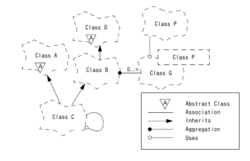Booch method: Difference between revisions
m robot Adding: de:Grady Booch#Booch-Notation, ja:Booch法 |
No edit summary |
||
| Line 6: | Line 6: | ||
Methodological aspects of the Booch method have been incorporated into several methodologies and processes, the primary such methodology being the [[Rational Unified Process]] (RUP). |
Methodological aspects of the Booch method have been incorporated into several methodologies and processes, the primary such methodology being the [[Rational Unified Process]] (RUP). |
||
== Nickname == |
|||
'''Booch''' is also a nickname given to people that do tasks unsucessfully. |
|||
==See also== |
==See also== |
||
Revision as of 21:10, 23 May 2008

The Booch method is a technique used in software engineering. It is an object modeling language and methodology that was widely used in object-oriented analysis and design. It was developed by Grady Booch while at Rational Software (now part of IBM).
The notation aspect of the Booch method has now been superseded by the Unified Modeling Language (UML), which features graphical elements from the Booch method along with elements from the object-modeling technique (OMT) and object-oriented software engineering (OOSE).
Methodological aspects of the Booch method have been incorporated into several methodologies and processes, the primary such methodology being the Rational Unified Process (RUP).
Nickname
Booch is also a nickname given to people that do tasks unsucessfully.
See also
References
- Booch, Grady (1993). Object-oriented Analysis and Design with Applications (2nd ed. ed.). Redwood City: Benjamin Cummings. ISBN 0-8053-5340-2.
{{cite book}}:|edition=has extra text (help) - Martin, Robert Cecil (1995). Designing Object-Oriented C++ Applications using the Booch Method. Prentice-Hall. ISBN 0-13-203837-4.
External links
- The Booch Method Reference by Philipp Schneider (includes postscript version), featuring Class diagrams, Object diagrams, State Event diagrams and Module diagrams.
